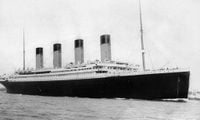In a remarkable exploration of history, Stephen McGann, known for his role in BBC's "Call the Midwife," has uncovered the harrowing survival story of his great-uncle, Jimmy McGann, who worked aboard the RMS Titanic. This journey into the past sheds light on the often-overlooked laborers who powered the ill-fated vessel, revealing a narrative that intertwines personal family history with one of the most infamous maritime disasters in history.
The Titanic, which sank 113 years ago this month, is often romanticized in popular culture, conjuring images of opulence and grandeur. However, beneath the luxurious surface lay a stark reality for the working-class men who toiled in extreme conditions. Jimmy McGann was part of the "Black Gang," a group responsible for shoveling coal into the ship's boilers. These men, predominantly Irish Catholics who had fled the potato famine, endured grueling work without breaks for food or relief, laboring in sweltering heat.
Stephen recalls the moment he first learned about his great-uncle's connection to the Titanic from his Aunt Mary. "It was amazing," he said, although she had no concrete details to share. Years later, a breakthrough came when Stephen's wife discovered a mention of "James McGann" in Colonel Archibald Gracie's memoir, "The Truth About the Titanic." "It was a Spielberg focus-pull moment," he described, realizing his aunt's story was true.
As the Titanic embarked on its maiden voyage, Jimmy and his fellow workers found themselves in a precarious situation. The ship struck an iceberg at 11:40 PM on April 14, 1912, and the Black Gang was ordered to remain at their posts until 1:40 AM, just 40 minutes before the ship sank. By the time Jimmy made it to the deck around 1:50 AM on April 15, he found that all the main lifeboats had already departed.
In a desperate attempt to escape, Jimmy and others tried to launch "Collapsible A," but it was stuck. They then turned to "Collapsible B," which tragically capsized when a large wave hit as they attempted to launch it. Facing the chaos of the sinking ship, Jimmy encountered Captain Edward J. Smith, who reportedly said, "You've done your duty, I release you all... It's every man for himself." With that, Jimmy jumped into the frigid waters, where the temperature was a bone-chilling -2 degrees Celsius.
By sheer luck, he was swept near the overturned Collapsible B, which was now a makeshift raft for around 30 survivors. The situation was dire; the raft was dangerously overloaded, and those on board had to push away friends and colleagues struggling in the icy water. Stephen described this moment as a "Dante's Inferno" as the desperate cries of those in the water echoed across the Atlantic.
As dawn broke, the survivors on the raft recited the Lord’s Prayer, scanning the horizon for any sign of rescue. Finally, they spotted the lights of the Carpathia in the distance. However, their troubles were far from over. The raft was slowly sinking, but they managed to attract the attention of another lifeboat with extra room.
At 8:30 AM, after six grueling hours in the icy water, Jimmy and his fellow survivors were rescued. They were among the last people pulled from the Atlantic that day. Suffering from frostbite, Jimmy received treatment at St. Vincent's Hospital in New York before returning to England, where he remarkably went back to work as a seaman. "They were a tough breed," Stephen noted, reflecting on the resilience of the men who survived such a harrowing ordeal.
Tragically, Jimmy's life was cut short just a few years after the disaster when he died of pneumonia. Without Stephen's dedication to uncovering his family history, Jimmy's story might have been lost to time. "When you do genealogy," Stephen reflected, "one of the most quietly rewarding things is that there are souls inside those records who [haven't been thought of] for more than 100 years. The minute you say the name out loud, there's somebody there again... This is who I am. This is my story. I lived once and this happened to me."
In a related note, 113 years after the Titanic sank, the Kilroy stoking transmitter, a crucial part of the ship’s engine, is now on display at the TITANIC: The Artifact Exhibition in Las Vegas. Recovered during a 1994 expedition, the transmitter was essential for signaling when to shovel coal into the ship's boilers. Tomasina Ray, President of RMS Titanic, Inc., emphasized the importance of this artifact, saying it connects directly to the human effort required to keep the Titanic moving, showcasing the incredible physical labor of the stokers and crew.
Visitors to the exhibition can see this piece of history and learn more about the technological advancements and labor that powered the Titanic's ill-fated journey. The exhibition is open daily from 11 AM to 8 PM, with final admission at 7 PM. For more information and to purchase tickets, interested parties can visit TitanicLasVegas.com.
As the Titanic's story continues to resonate through generations, the efforts of individuals like Stephen McGann ensure that the lives and sacrifices of those who worked aboard the ship are remembered. Their stories, often overshadowed by the tragedy itself, reveal the human spirit's resilience and the importance of acknowledging every voice in history.






